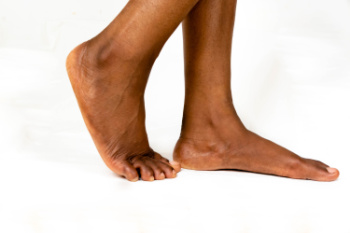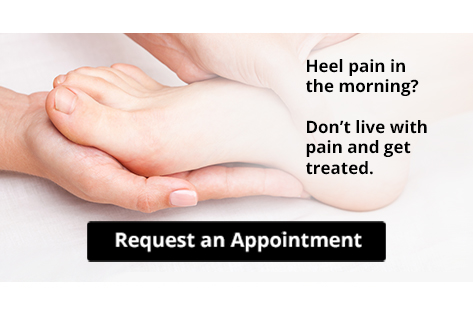Connect With Us
Blog

Plantar fasciitis is a major cause of heel pain. It occurs when the plantar fascia, a thick band of tissue along the bottom of the foot, undergoes degeneration at its attachment on the heel. This often leads to sharp pain near the heel, especially when standing up after rest. Plantar fasciitis is linked to excessive foot pronation, high or low arches and prolonged standing. Other factors include running, wearing improper footwear, and being overweight, along with tight calf muscles and a stiff Achilles tendon. A podiatrist can assess your foot structure, gait mechanics, and risk factors to determine the best course of treatment. Supportive footwear, custom orthotics, and stretching exercises may help reduce strain on the plantar fascia. If symptoms persist, a podiatrist may suggest corticosteroid injections to relieve inflammation or night splints to keep the fascia stretched. Surgery is considered when pain does not improve with other treatments. If you have symptoms of plantar fasciitis, it is suggested that you schedule an appointment with a podiatrist for an exam, diagnosis, and treatment options.
Plantar fasciitis can be very painful and inconvenient. If you are experiencing heel pain or symptoms of plantar fasciitis, contact Troy Wilde, DPM from Practice. Our doctor can provide the care you need to keep you pain-free and on your feet.
What Is Plantar Fasciitis?
Plantar fasciitis is the inflammation of the thick band of tissue that runs along the bottom of your foot, known as the plantar fascia, and causes mild to severe heel pain.
What Causes Plantar Fasciitis?
- Excessive running
- Non-supportive shoes
- Overpronation
- Repeated stretching and tearing of the plantar fascia
How Can It Be Treated?
- Conservative measures – anti-inflammatories, ice packs, stretching exercises, physical therapy, orthotic devices
- Shockwave therapy – sound waves are sent to the affected area to facilitate healing and are usually used for chronic cases of plantar fasciitis
- Surgery – usually only used as a last resort when all else fails. The plantar fascia can be surgically detached from the heel
While very treatable, plantar fasciitis is definitely not something that should be ignored. Especially in severe cases, speaking to your doctor right away is highly recommended to avoid complications and severe heel pain. Your podiatrist can work with you to provide the appropriate treatment options tailored to your condition.
If you have any questions please feel free to contact our offices located in Phoenix, Gilbert, and Chandler, AZ . We offer the newest diagnostic and treatment technologies for all your foot and ankle needs.

A burning sensation in the toes can result from nerve damage, poor circulation, or external factors like pressure and friction. Peripheral neuropathy, commonly linked to diabetes or excessive alcohol use, can impair nerve function and lead to persistent burning toe pain. Circulatory issues that restrict blood flow to the feet may also contribute to burning toe pain. Wearing ill-fitting shoes, prolonged pressure on the toes, or injuries such as burns or stubbing a toe can irritate nerves and result in a burning feeling. Certain autoimmune disorders, vitamin deficiencies, and infections like shingles can further damage nerves, leading to abnormal sensations. Other symptoms include tingling, numbness, or sharp pain, which can worsen at night or with activity. If the burning sensation persists or worsens, a podiatrist can perform an exam to determine the underlying cause. Treatment may involve addressing nerve damage, improving circulation, or making footwear adjustments to relieve pressure on the toes. If your toes feel like they are burning, it is suggested that you schedule an appointment with a podiatrist for an exam, diagnosis, and treatment.
Toe pain can disrupt your daily activities. If you have any concerns, contact Troy Wilde, DPM of Practice. Our doctor can provide the care you need to keep you pain-free and on your feet.
What Causes Toe Pain?
Most severe toe pain is caused due to a sports injury, trauma from dropping something heavy on the toe, or bumping into something rigid. Other problems can develop over time for various reasons.
Toe pain can be caused by one or more ailments. The most common include:
- Trauma
- Sports injury
- Wearing shoes that are too tight
- Arthritis
- Gout
- Corns and calluses
- Hammertoe
- Bunions
- Blisters
- Ingrown toenails
- Sprains
- Fractures (broken bones)
- Dislocations
When to See a Podiatrist
- Severe pain
- Persistent pain that lasts more than a week
- Signs of infection
- Continued swelling
- Pain that prevents walking
Diagnosis
In many cases the cause of toe pain is obvious, but in others, a podiatrist may want to use more advanced methods to determine the problem. These can range from simple visual inspections and sensation tests to X-rays and MRI scans. Prior medical history, family medical history, and any recent physical traumatic events will all be taken into consideration for a proper diagnosis.
Treatment
Treatments for toe pain and injuries vary and may include shoe inserts, padding, taping, medicines, injections, and in some cases, surgery. If you believe that you have broken a toe, please see a podiatrist as soon as possible.
If you have any questions please feel free to contact our offices located in Phoenix, Gilbert, and Chandler, AZ . We offer the newest diagnostic tools and technology to treat your foot and ankle needs.

Flat feet, also known as fallen arches, occur when the arch of the foot collapses, causing the entire foot to make contact with the ground. There are two types, which are flexible and rigid. Flexible flat feet are more common and typically cause discomfort after standing or walking for long periods. Rigid flat feet, which are less flexible, can cause significant pain, especially when walking or running. Symptoms include pain in the arch, heel, or knees, and you may notice that your feet appear to roll inward. The causes of flat feet include genetics, injury, or weakened tendons. A podiatrist can help by evaluating your foot structure and offering treatments like custom orthotics to support the arch, exercises to strengthen the foot, and surgery for more severe cases. If you have flat feet, it is suggested that you schedule an appointment with a podiatrist to get the right treatment and improve comfort.
Flatfoot is a condition many people suffer from. If you have flat feet, contact Troy Wilde, DPM from Practice. Our doctor will treat your foot and ankle needs.
What Are Flat Feet?
Flatfoot is a condition in which the arch of the foot is depressed and the sole of the foot is almost completely in contact with the ground. About 20-30% of the population generally has flat feet because their arches never formed during growth.
Conditions & Problems:
Having flat feet makes it difficult to run or walk because of the stress placed on the ankles.
Alignment – The general alignment of your legs can be disrupted, because the ankles move inward which can cause major discomfort.
Knees – If you have complications with your knees, flat feet can be a contributor to arthritis in that area.
Symptoms
- Pain around the heel or arch area
- Trouble standing on the tip toe
- Swelling around the inside of the ankle
- Flat look to one or both feet
- Having your shoes feel uneven when worn
Treatment
If you are experiencing pain and stress on the foot you may weaken the posterior tibial tendon, which runs around the inside of the ankle.
If you have any questions please feel free to contact our offices located in Phoenix, Gilbert, and Chandler, AZ . We offer the newest diagnostic and treatment technologies for all your foot and ankle needs.
Blog Archives
- March 2025
- February 2025
- January 2025
- December 2024
- November 2024
- October 2024
- September 2024
- August 2024
- July 2024
- June 2024
- May 2024
- April 2024
- March 2024
- February 2024
- January 2024
- December 2023
- November 2023
- October 2023
- September 2023
- August 2023
- July 2023
- June 2023
- May 2023
- April 2023
- March 2023
- February 2023
- January 2023
- December 2022
- November 2022
- October 2022
- September 2022
- August 2022
- July 2022
- June 2022
- May 2022
- April 2022
- March 2022
- February 2022

